Editor guide
Md-math-field is made with carta-md and mathlive (so if you want, you can go straight to the source docs). It supports:
- markdown
- katex math
- tikzjax with these tikz packages:
- chemfig
- tikz-cd
- circuitikz
- pgfplots
- array
- amsmath
- amstext
- amsfonts
- amssymb
- tikz-3dplot
Latex examples
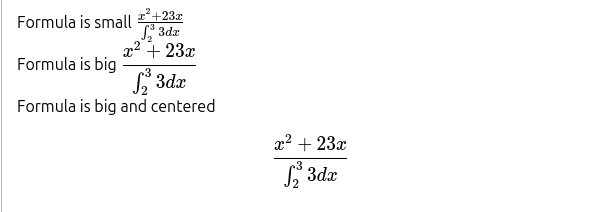
Formula is small $\frac{x^2+23x}{\int_2^3 3 dx}$\
Formula is big $\displaystyle \frac{x^2+23x}{\int_2^3 3 dx}$\
Formula is big and centered
$$
\frac{x^2+23x}{\int_2^3 3 dx}
$$
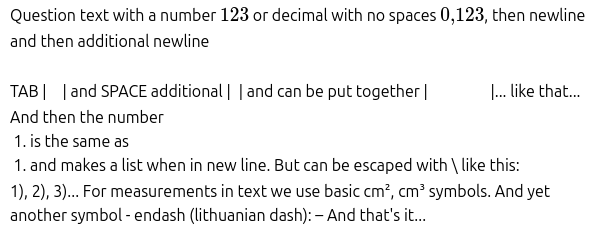
Question text with a number $123$ or decimal with no spaces $0{,}123$, then newline
and then additional newline
\
TAB | | and SPACE additional | | and can be put together |       |... like that...
And then the number
1. is the same as
1) and makes a list when in new line. But can be escaped with \ like this:
1\), 2\), 3\)... For measurements in text we use basic cm², cm³ symbols. And yet another symbol - endash (lithuanian dash): – And that's it...
Closed question with choices...
**A** Choice $1$  
**B** Choice $2$  
**C** Choice $3$  
**D** Choice $4$
Useful tikz examples (math templates)
```tikz
\begin{document}
\begin{tikzpicture}[scale=1.5]
\coordinate (A) at (-2,-1);
\coordinate (B) at (-2,1);
\coordinate (C) at (2,1);
\coordinate (D) at (2,-1);
\draw (A) -- (B) -- (C) -- (D) -- (A) -- (C);
\draw (B) -- (D);
\node[left, scale=1.5] at (A) {$A$};
\node[left, scale=1.5] at (B) {$B$};
\node[right, scale=1.5] at (C) {$C$};
\node[right, scale=1.5] at (D) {$D$};
\node[below, scale=1.5] at (0,0) {$O$};
\node[below, scale=1.5] at (0,-1) {$x+4$};
\node[left, scale=1.5] at (-2,0) {$x$};
\end{tikzpicture}
\end{document}
```
```tikz
\begin{document}
\begin{tikzpicture}
% Axis
\draw (-2,0) -- (2,0);
\fill (2,0) -- (1.8,0.1) -- (1.8,-0.1) -- cycle;
\node[below, scale=1.5] at (1.9,0) {$x$};
\coordinate (-B) at (-1.8,0);
\coordinate (B) at (-1,0);
\coordinate (BC) at (0,0);
\coordinate (C) at (1,0);
\coordinate (C+) at (1.7, 0);
\draw (B) circle (2pt);
\node[below, scale=1.5] at (B) {$0$};
\fill (C) circle (2pt);
\node[below, scale=1.5] at (C) {$\frac12$};
\node[above, scale=1.5] at (-B) {$-$};
\node[above, scale=1.5] at (BC) {$+$};
\node[above, scale=1.5] at (C+) {$-$};
\draw[thick] (B) arc[start angle=180, end angle=0, x radius=1, y radius=0.7];
\draw[thick] (C) arc[start angle=180, end angle=90, x radius=1, y radius=0.7];
\draw[thick] (B) arc[start angle=-360, end angle=-270, x radius=1, y radius=0.7];
\end{tikzpicture}
\end{document}
```
```tikz
\begin{document}
\begin{tikzpicture}
% Axis
\draw (-2,0) -- (2,0);
\fill (2,0) -- (1.8,0.1) -- (1.8,-0.1) -- cycle;
\node[below, scale=1.5] at (1.9,0) {$x$};
\coordinate (-B) at (-1.8,0);
\coordinate (B) at (-1,0);
\coordinate (BC) at (0,0);
\coordinate (C) at (1,0);
\coordinate (C+) at (1.7, 0);
\fill (B) circle (2pt);
\node[below, scale=1.5] at (-1.2,0) {$0$};
\draw (C) circle (2pt);
\node[below, scale=1.5] at (C) {$1$};
\node[above, scale=1.5] at (-B) {$+$};
\node[above, scale=1.5] at (BC) {$-$};
\node[above, scale=1.5] at (C+) {$+$};
\draw[thick, domain=-2:2, samples=100] plot (\x, {0.7*(\x+1)*(\x-1)});
\end{tikzpicture}
\end{document}
```

```tikz
\begin{document}
\begin{tikzpicture}
% Axis
\draw (-6,0) -- (2,0);
\fill (2,0) -- (1.8,0.1) -- (1.8,-0.1) -- cycle;
\node[below, scale=1.5] at (1.7,0) {$x$};
% Interval start point
\coordinate (-B) at (-6,0);
\coordinate (B) at (-4,0);
\coordinate (C) at (-2,0);
\coordinate (D) at (0,0);
\coordinate (D+) at (1.7, 0);
\draw (B) circle (1.5pt);
\node[below, scale=1.5] at (B) {$-4$};
\fill (C) circle (1.5pt);
\node[below, scale=1.5] at (C) {$-\frac12$};
\draw (D) circle (1.5pt);
\node[below, scale=1.5] at (D) {$\frac23$};
\foreach \x in {-6,-5.85,...,0} {
\draw (\x,0) -- (\x-0.5,0.4);
}
\foreach \x in {-4, -3.85,...,1.7} {
\draw (\x,0) -- (\x-0.5,-0.4);
}
\foreach \x in {-2, -1.85,...,1.7} {
\draw (\x,0) -- (\x+0.5,-0.4);
}
\end{tikzpicture}
\end{document}
```
```tikz
\usepackage{pgfplots}
\begin{document}
\begin{tikzpicture}
\begin{axis}[
axis lines=middle,
xlabel={$x$},
ylabel={$y$},
samples=100,
domain=0:9,
ymin=0, ymax=5,
xmin=-0.5, xmax=9,
xtick={0,1},
ytick={0,1,2},
extra x ticks={0},
extra x tick labels={$0$},
extra x tick style={tick label style={font=\small}},
tick label style={font=\small},
scale only axis,
width=7cm,
height=3cm
]
\addplot[thick, violet] {sqrt(x) + 2};
\end{axis}
\end{tikzpicture}
\end{document}
```
```tikz
\usepackage{pgfplots}
\begin{document}
\begin{tikzpicture}
\begin{axis}[
axis lines=middle,
xlabel={$x$},
ylabel={$y$},
samples=100,
domain=-4:4,
ymin=-3, ymax=5,
xmin=-4, xmax=4,
xtick={0,2},
ytick={0},
extra x ticks={-0.2},
extra x tick labels={$0$},
extra x tick style={tick label style={font=\small}},
tick label style={font=\small},
scale only axis,
width=5cm,
height=5cm
]
\addplot[thick, violet] {x^2-2*x};
\addplot[only marks, mark=*, mark size=1pt, black] coordinates {(2,0)};
\addplot[only marks, mark=*, mark size=1pt, black] coordinates {(0,0)};
\end{axis}
\end{tikzpicture}
\end{document}
```
```tikz
\begin{document}
\begin{tikzpicture}
% Axis
\draw (-4,0) -- (2,0);
\fill (2,0) -- (1.8,0.1) -- (1.8,-0.1) -- cycle;
\node[below, scale=1.5] at (1.9,0) {$x$};
\coordinate (-A) at (-3.7,0);
\coordinate (A) at (-3,0);
\coordinate (AB) at (-2,0);
\coordinate (B) at (-1,0);
\coordinate (BC) at (0,0);
\coordinate (C) at (1,0);
\coordinate (C+) at (1.7, 0);
\draw (A) circle (2pt);
\node[below, scale=1.5] at (A) {$0$};
\draw (B) circle (2pt);
\node[below, scale=1.5] at (B) {$1$};
\draw (C) circle (2pt);
\node[below, scale=1.5] at (C) {$3$};
\node[above, scale=1.5] at (-A) {$-$};
\node[above, scale=1.5] at (AB) {$+$};
\node[above, scale=1.5] at (BC) {$-$};
\node[above, scale=1.5] at (C+) {$+$};
\draw[thick] (A) arc[start angle=180, end angle=0, x radius=1, y radius=0.7];
\draw[thick] (B) arc[start angle=180, end angle=0, x radius=1, y radius=0.7];
\draw[thick] (C) arc[start angle=180, end angle=90, x radius=1, y radius=0.7];
\draw[thick] (A) arc[start angle=-360, end angle=-270, x radius=1, y radius=0.7];
\end{tikzpicture}
\end{document}
```
```tikz
\begin{document}
\begin{tikzpicture}
% Axis
\draw (-2,0) -- (2,0);
\fill (2,0) -- (1.8,0.1) -- (1.8,-0.1) -- cycle;
\node[below, scale=1.5] at (1.9,0) {$x$};
\coordinate (-B) at (-0.8,0);
\coordinate (B) at (0,0);
\coordinate (BC) at (0.8,0);
\draw (B) circle (2pt);
\node[below, scale=1.5] at (B) {$3$};
\node[above, scale=1.5] at (-B) {$-$};
\node[above, scale=1.5] at (BC) {$-$};
\draw[thick] (B) arc[start angle=180, end angle=90, x radius=1, y radius=0.7];
\draw[thick] (B) arc[start angle=-360, end angle=-270, x radius=1, y radius=0.7];
\end{tikzpicture}
\end{document}
```
More tikz examples
```tikz
\begin{document}
\begin{tikzpicture}
% Draw grid
\draw[step=1cm,very thin,color=black!50] (-5,-5) grid (5,5);
% Draw axes
\draw[->] (-4.2,0) -- (4.2,0) node[below] {$x$};
\draw[->] (0,-4.2) -- (0,4.2) node[right] {$y$};
% Draw absolute value function
\draw[thick,blue,domain=-4:4] plot (\x,{abs(\x)}) node[right] {$y = |x|$};
% Draw horizontal line y=2
\draw[thick,green!80!black] (-4,2) -- (4,2) node[right] {$y = 2$};
% Labels for specific points
\node[below] at (1,0) {1};
\node[left] at (0,1) {1};
\end{tikzpicture}
\end{document}
```
```tikz
\begin{document}
\begin{tikzpicture}
% Draw grid
\draw[step=1cm,very thin,color=black!50] (-5,-2) grid (5,6);
% Draw axes
\draw[->] (-4.2,0) -- (4.2,0) node[below] {$x$};
\draw[->] (0,-2.1) -- (0,5.2) node[right] {$y$};
% Draw absolute value function
\draw[thick,blue,domain=-2.5:2.5] plot (\x,{pow(\x, 2)}) node[right] {$y = x^2$};
% Labels for specific points
\node[below] at (1,0) {1};
\node[left] at (0,1) {1};
\end{tikzpicture}
\end{document}
```
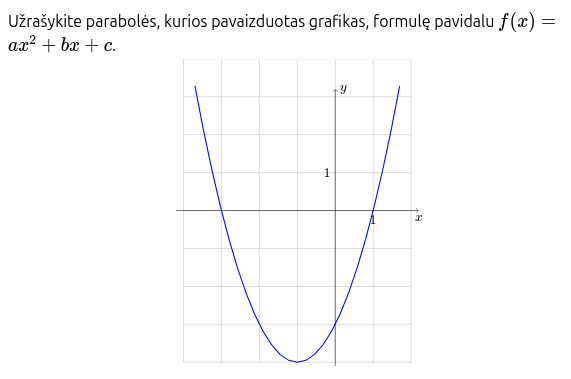
Užrašykite parabolės, kurios pavaizduotas grafikas, formulę
pavidalu $f(x) = ax^2 + bx + c$.
```tikz
\begin{document}
\begin{tikzpicture}
% Draw grid
\draw[step=1cm,very thin,color=black!50] (-4,-4) grid (2,4);
% Draw axes
\draw[->] (-4.2,0) -- (2.2,0) node[below] {$x$};
\draw[->] (0,-4.1) -- (0,3.2) node[right] {$y$};
% Draw absolute value function
\draw[thick,blue,domain=-3.7:1.7] plot (\x,{pow(\x, 2) + 2 * \x - 3});
% Labels for specific points
\node[below] at (1,0) {1};
\node[left] at (0,1) {1};
\end{tikzpicture}
\end{document}
```
Generic tikz examples
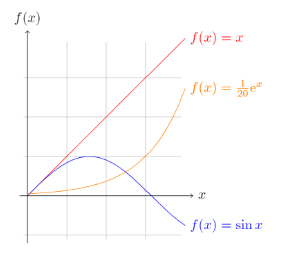
```tikz
\begin{document}
\begin{tikzpicture}[domain=0:4]
\draw[very thin,color=gray] (-0.1,-1.1) grid (3.9,3.9);
\draw[->] (-0.2,0) -- (4.2,0) node[right] {$x$};
\draw[->] (0,-1.2) -- (0,4.2) node[above] {$f(x)$};
\draw[color=red] plot (\x,\x) node[right] {$f(x) =x$};
\draw[color=blue] plot (\x,{sin(\x r)}) node[right] {$f(x) = \sin x$};
\draw[color=orange] plot (\x,{0.05*exp(\x)}) node[right] {$f(x) = \frac{1}{20} \mathrm e^x$};
\end{tikzpicture}
\end{document}
```
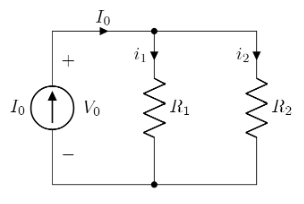
```tikz
\usepackage{circuitikz}
\begin{document}
\begin{circuitikz}[american, voltage shift=0.5]
\draw (0,0)
to[isource, l=$I_0$, v=$V_0$] (0,3)
to[short, -*, i=$I_0$] (2,3)
to[R=$R_1$, i>_=$i_1$] (2,0) -- (0,0);
\draw (2,3) -- (4,3)
to[R=$R_2$, i>_=$i_2$]
(4,0) to[short, -*] (2,0);
\end{circuitikz}
\end{document}
```
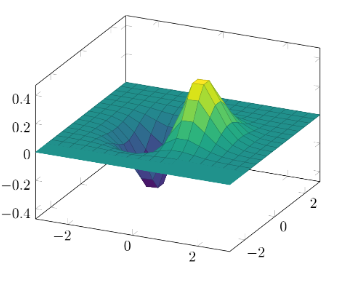
```tikz
\usepackage{pgfplots}
\pgfplotsset{compat=1.16}
\begin{document}
\begin{tikzpicture}
\begin{axis}[colormap/viridis]
\addplot3[
surf,
samples=18,
domain=-3:3
]
{exp(-x^2-y^2)*x};
\end{axis}
\end{tikzpicture}
\end{document}
```
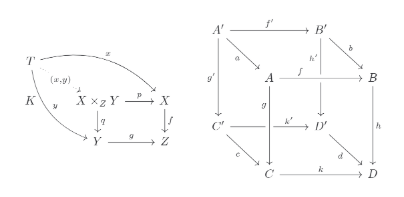
```tikz
\usepackage{tikz-cd}
\begin{document}
\begin{tikzcd}
T
\arrow[drr, bend left, "x"]
\arrow[ddr, bend right, "y"]
\arrow[dr, dotted, "{(x,y)}" description] & & \\
K & X \times_Z Y \arrow[r, "p"] \arrow[d, "q"]
& X \arrow[d, "f"] \\
& Y \arrow[r, "g"]
& Z
\end{tikzcd}
\quad \quad
\begin{tikzcd}[row sep=2.5em]
A' \arrow[rr,"f'"] \arrow[dr,swap,"a"] \arrow[dd,swap,"g'"] &&
B' \arrow[dd,swap,"h'" near start] \arrow[dr,"b"] \\
& A \arrow[rr,crossing over,"f" near start] &&
B \arrow[dd,"h"] \\
C' \arrow[rr,"k'" near end] \arrow[dr,swap,"c"] && D' \arrow[dr,swap,"d"] \\
& C \arrow[rr,"k"] \arrow[uu,<-,crossing over,"g" near end]&& D
\end{tikzcd}
\end{document}
```

```tikz
\usepackage{chemfig}
\begin{document}
\chemfig{[:-90]HN(-[::-45](-[::-45]R)=[::+45]O)>[::+45]*4(-(=O)-N*5(-(<:(=[::-60]O)-[::+60]OH)-(<[::+0])(<:[::-108])-S>)--)}
\end{document}
```
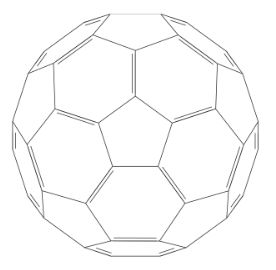
```tikz
\usepackage{chemfig}
\begin{document}
\definesubmol\fragment1{
(-[:#1,0.85,,,draw=none]
-[::126]-[::-54](=_#(2pt,2pt)[::180])
-[::-70](-[::-56.2,1.07]=^#(2pt,2pt)[::180,1.07])
-[::110,0.6](-[::-148,0.60](=^[::180,0.35])-[::-18,1.1])
-[::50,1.1](-[::18,0.60]=_[::180,0.35])
-[::50,0.6]
-[::110])
}
\chemfig{
!\fragment{18}
!\fragment{90}
!\fragment{162}
!\fragment{234}
!\fragment{306}
}
\end{document}
```
Where to generate tikz?
Geogebra (PC app)
File > Export > Graphics View as PGF/Tikz > Generate PGF/Tikz code > Copy everything except the first \documentclass line
Mathcha
Tutorial coming soon...